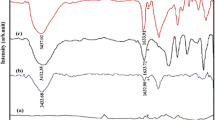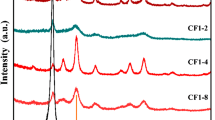Abstract
Polystyrene template microspheres of narrow size distribution were prepared by dispersion polymerization of styrene in a mixture of ethanol and 2-methoxy ethanol. These template particles dispersed in aqueous solution have been used for the entrapment of ferrocene by a swelling process of methylene chloride emulsion droplets containing ferrocene within these particles, followed by evaporation of methylene chloride. The effects of CH2Cl2 volume and the [CH2Cl2]/[FeC10H10] (w/w) ratio on the size and size distribution of the swollen template particles were elucidated. Air-stable Fe3C nanoparticles embedded in amorphous carbon matrix (Fe3C/C) have been prepared by thermal decomposition of the ferrocene-swollen template polystyrene particles at 500 °C for 2 h in a sealed cell. Decomposition of these swollen template particles for 2 h at higher temperatures led to the formation of carbon nanotubes (CNTs) in addition to the Fe3C/C composite nanoparticles. The yield of the CNTs increased as the annealing temperature was raised. An opposite behavior was observed for the diameter of the formed CNTs. The size and size distribution, crystallinity, and magnetic properties of the different Fe3C/C composite nanoparticles have also been controlled by the annealing temperature.









Similar content being viewed by others
References
Yi DK, Lee SS, Ying JY (2006) Synthesis and applications of magnetic nanocomposite catalysts. Chem Mater 18(10):2459–2461
Huber DL (2005) Synthesis, properties, and applications of iron nanoparticles. Small 1(5):482–501
Amara D, Margel S (2011) Solventless thermal decomposition of ferrocene as a new approach for the synthesis of porous superparamagnetic and ferromagnetic composite microspheres of narrow size distribution. J Mater Chem 21(39):15764–15772
Amara D, Felner I, Nowik I, Margel S (2009) Synthesis and characterization of Fe and Fe3O4 nanoparticles by thermal decomposition of triiron dodecacarbonyl. Colloid Surf A 339(1–3):106–110
Amara D, Margel S (2012) Synthesis and characterization of superparamagnetic core–shell micrometre-sized particles of narrow size distribution by a swelling process. J Mater Chem 22(18):9268–9276
Amara D, Grinblat J, Margel S (2010) Synthesis of magnetic iron and iron oxide micrometre-sized composite particles of narrow size distribution by annealing iron salts entrapped within uniform porous poly(divinylbenzene) microspheres. J Mater Chem 20(10):1899–1906
Valdés-Solís T, Rebolledo AF, Sevilla M, Valle-Vigón P, Bomatí-Miguel O, Fuertes AB et al (2009) Preparation, characterization, and enzyme immobilization capacities of superparamagnetic silica/iron oxide nanocomposites with mesostructured porosity. Chem Mater 21(9):1806–1814
Jay F, Gauthier V, Dubois S (2006) Iron particles coated with alumina: synthesis by a mechanofusion process and study of the high-temperature oxidation resistance. J Am Ceram Soc 89(11):3522–3528
Wang JN, Zhang L, Yu F, Sheng ZM (2007) Synthesis of carbon encapsulated magnetic nanoparticles with giant coercivity by a spray pyrolysis approach. J Phys Chem B 111(8):2119–2124
Herrmann IK, Grass RN, Mazunin D, Stark WJ (2009) Synthesis and covalent surface functionalization of nonoxidic iron core–shell nanomagnets. Chem Mater 21(14):3275–3281
Huo J, Song H, Chen X, Lian W (2006) Formation and transformation of carbon-encapsulated iron carbide/iron nanorods. Carbon 44(13):2849–2852
Dresselhaus MS, Dresselhaus G, Jorio A (2004) Unusual properties and structure of carbon nanotubes. Ann Rev Mater Res 34(1):247–278
Wu Q, Low TS (2001) Magnetic nanostructures grown on vertically aligned carbon nanotube templates. Nano Lett 2(2):161–164
Majetich SA, Artman JO, Mchenry ME, Nuhfer NT, Staley SW (1993) Preparation and properties of carbon-coated magnetic nanocrystallites. Phys Rev B 48(22):16845–16848
Xu L, Zhang W, Ding Y, Peng Y, Zhang S, Yu W et al (2004) Formation, characterization, and magnetic properties of Fe3O4 nanowires encapsulated in carbon microtubes. J Phys Chem B 108(30):10859–10862
Yang F, Jin C, Yang D, Jiang Y, Li J, Di Y et al (2011) Magnetic functionalised carbon nanotubes as drug vehicles for cancer lymph node metastasis treatment. Eur J Cancer 47(12):1873–1882
Zhang XF, Dong XL, Huang H, Liu YY, Wang WN, Zhu XG et al (2006) Microwave absorption properties of the carbon-coated nickel nanocapsules. Appl Phys Lett 89(5):053115–053115-3
Korneva G, Ye H, Gogotsi Y, Halverson D, Friedman G, Bradley JC et al (2005) Carbon nanotubes loaded with magnetic particles. Nano Lett 5(5):879–884
Sun Z, Liu Z, Wang Y, Han B, Du J, Zhang J (2005) Fabrication and characterization of magnetic carbon nanotube composites. J Mater Chem 15(42):4497–4501
Georgakilas V, Tzitzios V, Gournis D, Petridis D (2005) Attachment of magnetic nanoparticles on carbon nanotubes and their soluble derivatives. Chem Mater 17(7):1613–1617
Bamnolker H, Margel S (1996) Dispersion polymerization of styrene in polar solvents: effect of reaction parameters on microsphere surface composition and surface properties, size and size distribution, and molecular weight. J Polym Sci A1 34(10):1857–1871
Shimei J, Yue W (1999) Vibrational spectra of an open ferrocene and a half-open ferrocene. Spectrochim Acta A 55(5):1025–1033
Futaba DN, Goto J, Yasuda S, Yamada T, Yumura M, Hata K (2009) General rules governing the highly efficient growth of carbon nanotubes. Adv Mater 21(47):4811–4815
Schnepp Z, Wimbush SC, Antonietti M, Giordano C (2010) Synthesis of highly magnetic iron carbide nanoparticles via a biopolymer route. Chem Mater 22(18):5340–5344
Kodama RH (1999) Magnetic nanoparticles. Kodama J Magn Magn Mater 200(1–3):359–372
Acknowledgments
This study was partially supported by a Minerva Grant (Micro & Nano scale Particles and Thin Films for Biomedical Applications).
Author information
Authors and Affiliations
Corresponding author
Rights and permissions
About this article
Cite this article
Amara, D., Margel, S. Synthesis and characterization of ferromagnetic Fe3C/C composite nanoparticles as a catalyst for carbon nanotube growth. Colloid Polym Sci 291, 2121–2129 (2013). https://doi.org/10.1007/s00396-013-2949-2
Received:
Revised:
Accepted:
Published:
Issue Date:
DOI: https://doi.org/10.1007/s00396-013-2949-2




